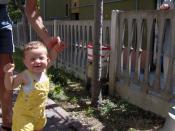There is a set of principles that characterizes the pattern and process of growth and development. These principles or characteristics describe typical development as a predictable and orderly process; that is, we can predict how most children will develop and that they will develop at the same rate and at about the same time as other children. Although there are individual differences in children's personalities, activity levels, and timing of developmental milestones, such as ages and stages, the principles and characteristics of development are universal patterns.
PRINCIPLES OF DEVELOPMENT
Development proceeds from the head downward:
This is called the cephalocaudle principle. This principle describes the direction of growth and development. According to this principle, the child gains control of the head first, then the arms, and then the legs. Infants develop control of the head and face movements within the first two months after birth. In the next few months, they are able to lift themselves up by using their arms.
By 6 to 12 months of age, infants start to gain leg control and may be able to crawl, stand, or walk. Coordination of arms always precedes coordination of legs.
Development proceeds from the center of the body outward:
This is the principle of proximodistal development that also describes the direction of development. This means that the spinal cord develops before outer parts of the body. The child's arms develop before the hands and the hands and feet develop before the fingers and toes. Finger and toe muscles (used in fine motor dexterity) are the last to develop in physical development.
Development depends on maturation and learning:
Maturation refers to the sequential characteristic of biological growth and development. The biological changes occur in sequential order and give children new abilities. Changes in the brain and nervous system account largely...



I like the way writer use this information
i score this above average because its nice but no references
0 out of 0 people found this comment useful.